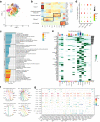Single-cell map of dynamic cellular microenvironment of radiation-induced intestinal injury
- PMID: 38071238
- PMCID: PMC10710489
- DOI: 10.1038/s42003-023-05645-w
Single-cell map of dynamic cellular microenvironment of radiation-induced intestinal injury
Abstract
Intestine is a highly radiation-sensitive organ that could be injured during the radiotherapy for pelvic, abdominal, and retroperitoneal tumors. However, the dynamic change of the intestinal microenvironment related to radiation-induced intestine injury (RIII) is still unclear. Using single-cell RNA sequencing, we pictured a dynamic landscape of the intestinal microenvironment during RIII and regeneration. We showed that the various cell types of intestine exhibited heterogeneous radiosensitivities. We revealed the distinct dynamic patterns of three subtypes of intestinal stem cells (ISCs), and the cellular trajectory analysis suggested a complex interconversion pattern among them. For the immune cells, we found that Ly6c+ monocytes can give rise to both pro-inflammatory macrophages and resident macrophages after RIII. Through cellular communication analysis, we identified a positive feedback loop between the macrophages and endothelial cells, which could amplify the inflammatory response induced by radiation. Besides, we identified different T cell subtypes and revealed their role in immunomodulation during the early stage of RIII through inflammation and defense response relevant signaling pathways. Overall, our study provides a valuable single-cell map of the multicellular dynamics during RIII and regeneration, which may facilitate the understanding of the mechanism of RIII.
© 2023. The Author(s).
Conflict of interest statement
The authors declare no competing interests.
Figures






References
Publication types
MeSH terms
Grants and funding
- 32270714/National Natural Science Foundation of China (National Science Foundation of China)
- 81573251/National Natural Science Foundation of China (National Science Foundation of China)
- 81672369/National Natural Science Foundation of China (National Science Foundation of China)
- 20180059/Beijing Nova Program
LinkOut - more resources
Full Text Sources
Molecular Biology Databases

